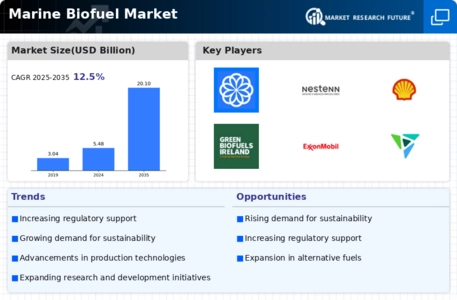Supportive Government Policies
Supportive government policies are playing a pivotal role in shaping the Marine Biofuel Market. Many governments are implementing regulations and incentives to promote the use of renewable energy sources, including marine biofuels. For instance, mandates for blending biofuels with traditional fuels are becoming more common, encouraging shipping companies to adopt cleaner alternatives. Additionally, financial incentives such as tax credits and grants for biofuel production are fostering growth in this sector. Recent statistics suggest that countries with robust policy frameworks for biofuels have seen a 20% increase in marine biofuel adoption. This supportive environment is crucial for the Marine Biofuel Market, as it not only stimulates demand but also encourages investment in infrastructure and technology.
Rising Demand for Sustainable Energy
The Marine Biofuel Market is experiencing a notable increase in demand for sustainable energy sources. This trend is driven by the need to reduce greenhouse gas emissions and combat climate change. As countries strive to meet international climate agreements, the adoption of marine biofuels is becoming more prevalent. According to recent data, the marine biofuel sector is projected to grow at a compound annual growth rate of approximately 10% over the next five years. This growth is indicative of a broader shift towards renewable energy solutions in the maritime sector, where traditional fossil fuels are being replaced by cleaner alternatives. The Marine Biofuel Market is thus positioned to play a crucial role in the transition towards a more sustainable energy landscape.
Investment in Research and Development
Investment in research and development is a critical driver for the Marine Biofuel Market. As technological advancements continue to emerge, companies are increasingly allocating resources to innovate and improve biofuel production processes. This investment is essential for enhancing the efficiency and cost-effectiveness of marine biofuels. Recent reports indicate that R&D spending in the biofuel sector has increased by over 15% in the past year, reflecting a growing recognition of the potential benefits of marine biofuels. Furthermore, advancements in feedstock processing and conversion technologies are likely to enhance the competitiveness of marine biofuels against conventional fuels. The Marine Biofuel Market stands to benefit significantly from these innovations, which may lead to more sustainable and economically viable biofuel options.
Increasing Shipping Industry Regulations
The increasing regulations within the shipping industry are significantly influencing the Marine Biofuel Market. Stricter emissions standards imposed by international maritime organizations are compelling shipping companies to seek alternative fuels that comply with these regulations. The International Maritime Organization has set ambitious targets for reducing greenhouse gas emissions from ships, which has led to a surge in interest in marine biofuels as a viable solution. As a result, many shipping companies are exploring partnerships with biofuel producers to ensure compliance and enhance their sustainability profiles. This regulatory pressure is likely to drive the Marine Biofuel Market forward, as companies adapt to meet new standards and reduce their environmental impact.
Consumer Preference for Eco-Friendly Products
Consumer preference for eco-friendly products is emerging as a significant driver for the Marine Biofuel Market. As awareness of environmental issues grows, consumers are increasingly favoring companies that prioritize sustainability in their operations. This shift in consumer behavior is prompting shipping companies to adopt marine biofuels as part of their commitment to reducing their carbon footprint. Recent surveys indicate that over 70% of consumers are willing to pay a premium for products and services that are environmentally friendly. This trend is likely to encourage more companies in the shipping sector to transition to marine biofuels, thereby expanding the market. The Marine Biofuel Market is thus poised to benefit from this evolving consumer landscape, as eco-conscious choices become more prevalent.

















